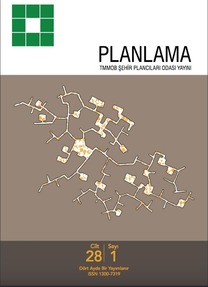Local Limits to Gentrification: Theory on the Move
Soylulaştırmaya Karşı Yerel Limitler: Dinamik Teori
___
Cabannes, Y., Yafai, S. G., & Johnson, C. (2010). How people face evictions. Project Report. Available in PDF from http://www. ucl. ac. uk/dpu/k_s/ publications/how_ppl_face_evictions (23 November 2010).Cameron, S., & Coaffee, J. (2005). Art, gentrification and regeneration–from artist as pioneer to public arts. European Journal of Housing Policy, 5(1), 39-58.
Caulfield, J. (1989). ‘Gentrification’and desire. Canadian Review of Sociology/ Revue canadienne de sociologie, 26(4), 617-632.
Clark, E. (1992). On blindness, centrepieces and complementarity in gentrification theory. Transactions of the Institute of British Geographers, 17(3), 358-362.
Glass, R. L. (1964). London: aspects of change (Vol. 3): MacGibbon & Kee.
González, S. (2016). Looking comparatively at displacement and resistance to gentrification in Latin American cities. Urban Geography, 37(8), 1245- 1252.
Günay, Z. (2015). Renewal agenda in Istanbul: Urbanisation vs. urbicide. ICONARP International Journal of Architecture and Planning, 1(3), 95-108
Hackworth, J., & Smith, N. (2001). The changing state of gentrification. Tijdschrift voor economische en sociale geografie, 92(4), 464-477.
Hartman, C. (1984/2002) Right to stay put, reprinted in: Between Eminence and Notoriety. New Brunswick, NJ: CUPR Press.
Islam, T., & Sakızlıoğlu, B. (2015). The making of, and resistance to, state-led gentrification in Istanbul, Turkey. In Lees, L., Shin, H. B. and López-Morales, E. (eds.) Global gentrifications: Uneven development and displacement (pp. 245-264). Policy Press, Bristol.
Jacobs, J. (1961). The death andlife of great american cities. Vintage, New York.
Janoschka, M., & Sequera, J. (2016). Gentrification in Latin America: addressing the politics and geographies of displacement. Urban Geography, 37(8), 1175-1194.
Lees, L. (2014). An Anti-Gentrification Handbook for Council Estates in London. ONLINE) https://southwarknotes. files. wordpress. com/2014/06/staying-put-web-version. pdf (05 January 2015).
Lees, L., & Ferreri, M. (2016). Resisting gentrification on its final frontiers: Learning from the Heygate Estate in London (1974–2013). Cities, 57, 14-24.
Lees, L., & Ley, D. (2008). Introduction to Special Issue on Gentrification and Public Policy. Urban Studies, 45(12), 2379-2384.
Lees, L., Slater, T., & Wyly, E. K. (2008). The gentrification reader: Routledge London.
Lees, L., Shin, H. B., & López-Morales, E. (2016). Planetary gentrification: Polity Press.
Levy, D. K., Comey, J., & Padilla, S. (2007). In the face of gentrification: Case studies of local efforts to mitigate displacement. Journal of Affordable Housing & Community Development Law, 238-315.
Ley, D. (1986). Alternative Explanations for Inner-City Gentrification: A Canadian Assessment. Annals of the Association of American Geographers, 76(4), 521-535.
Ley, D. (1996). The New Middle Class and the Remaking of the Central City: Oxford University Press.
Ley, D., & Dobson, C. (2008). Are there limits to gentrification? The contexts of impeded gentrification in Vancouver. Urban Studies, 45(12), 2471- 2498.
Maeckelbergh, M. (2013). Learning From Conflict: Innovative Approaches to Democratic Decision Making in the Alterglobalization Movement. Transforming Anthropology, 21(1), 27-40.
Marcuse, P. (1984). To control gentrification: anti-displacement zoning and planning for stable residential districts. NYU Rev. L. & Soc. Change, 13, 931-945.
Marcuse, P. (2013). Gentrification and Neighborhood Change: Clarity in Concepts. Paper presented at the RC21, Berlin.
Marcuse, P., Smith, N., & Williams, P. (1986). Abandonment, gentrification, and displacement: the linkages in New York City.
Massey, D. (1994). Space, place and gender, Polity Press.
Newman, K., & Wyly, E. K. (2006). The right to stay put, revisited: gentrification and resistance to displacement in New York City. Urban Studies, 43(1), 23-57.
Peck, J. (2015) Cities beyond Compare?, Regional Studies, 49 (1), 160-182,
Redfern, P. A. (1997). A new look at gentrification: 1. Gentrification and domestic technologies. Environment and Planning A, 29(7), 1275-1296.
Robinson, T. (1995). Gentrification and grassroots resistance in San Francisco’s Tenderloin. Urban Affairs Quarterly, 30(4), 483-513.
Robinson, J. (2003). Postcolonialising geography: tactics and pitfalls. Singapore Journal of Tropical Geography, 24(3), 273-289.
Shaw, K. (2004). Local limits to gentrification. In R. B. Atkinson, Gary (Ed.), Gentrification in a Global Context (pp. 168-184). London: Routledge.
Shin, H.B., Lees, L. and López-Morales, E. (2016) Introduction: Locating gentrification in the global East. Urban Studies 53 (3), 455-470.
Smith, N. (1996). The new urban frontier: gentrification and the revanchist city: Psychology Press.
Smith, N. (2002). New globalism, new urbanism: gentrification as global urban strategy. Antipode, 34(3), 427-450.
Uitermark, J., Duyvendak, J. W., & Kleinhans, R. (2007). Gentrification as a governmental strategy: social control and social cohesion in Hoogvliet, Rotterdam. Environment and Planning A, 39(1), 125.
Walks, A., & August, M. (2008). The factors inhibiting gentrification in areas with little non-market housing: policy lessons from the Toronto experience. Urban Studies, 45(12), 2594-2625.
Wyly, E., & Hammel, D. (2008). Commentary: urban policy frontiers. Urban Studies, 45(12), 2643-2648.
Wyly, E. K., & Hammel, D. J. (1999). Islands of decay in seas of renewal: Housing policy and the resurgence of gentrification. Housing Policy Debate, 10(4), 711-771.
Zukin, S. (1987). Gentrification: culture and capital in the urban core. Annual Review of Sociology, 13, 129-147.
Zukin, S. (1989). Loft living: culture and capital in urban change: Rutgers University Press.
Zukin, S., Kasinitz, P., & Chen, X. (2015). Global cities, local streets: Everyday diversity from New York to Shanghai: Routledge.
Zukin, S., Lindeman, S., & Hurson, L. (2015). The omnivore’s neighborhood? Online restaurant reviews, race, and gentrification. Journal of Consumer Culture, 1-21.
- ISSN: 1300-7319
- Yayın Aralığı: 3
- Başlangıç: 1986
- Yayıncı: TMMOB Şehir Plancıları Odası
Ersin TÜRK, Gökhan Hüseyin ERKAN
Arazi Kullanım - Ulaşım Planlaması Bütünlüğünde Uyum İçin Model Önerisi
Ali Kemal ÇINAR, Yenal AKGÜN, Hüseyin MARAL
The Impact of Mortgage Loans on the Financialization Process in Turkey
AHMET SUVAR ASLAN, İclal DİNÇER
Barış ERGEN, Muhammed özgür OĞUZ
Çocukların Orta-Yüksek Şiddetteki Fiziksel Aktivite Düzeyi Mekâna Göre Değişiyor mu?
Gözde EKŞİOĞLU ÇETİNTAHRA, Ebru ÇUBUKÇU
Airbnb’nin Soylulaşma Sürecine Etkisi: Kadıköy Rasimpaşa Mahallesi Örneği
potekli Konut Kredilerinin Türkiye’de Finansallaşmaya Etkisi
İclal DİNÇER, Ahmet Suvar ASLAN
Bir Kentsel Dönüşüm Deneyimi: Kadifekale-Uzundere İkileminde Bireysel Öyküler Üzerine Düşünmek
